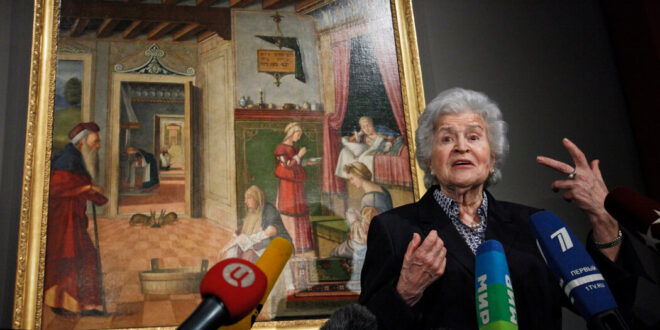MOSCOW — Irina A. Antonova, a commanding artwork historian who led the Pushkin State Museum of Superb Arts in Moscow for greater than a half-century, used it to deliver exterior tradition to remoted Soviet residents and turned it into a significant cultural establishment, died on Monday in that metropolis. She was 98.
The trigger was coronary heart failure sophisticated by a coronavirus an infection, the museum said.
Ms. Antonova steered the museum by means of the inflexible and isolationist cultural insurance policies of the Soviet Union and into the interval following the autumn of Communism. Lately she expanded the museum to adjoining buildings — typically angering their tenants — to accommodate mushrooming exhibitions.
From early on, Ms. Antonova used her inexhaustible power to construct connections with the world’s main museums. In 1974, she introduced the Mona Lisa from the Louvre in Paris. Tons of of hundreds of individuals lined as much as see it, the one queues the Soviet authorities was happy with on the time. Many knew that with the nation’s borders shut, it could be the only alternative to see that well-known Leonardo da Vinci work throughout their lifetimes.
She additional opened the world to the Soviet folks with an exhibition of 100 work from the Metropolitan Museum of Artwork in New York and the exhibition “Treasures of Tutankhamen.”
On Ms. Antonova’s watch, the Pushkin museum additionally exhibited summary and avant-garde works by Russian and worldwide artists. That was typically unimaginable in a rustic the place an unofficial artwork present was as soon as damaged up with the assistance of a bulldozer, and whose chief on the time, Nikita S. Khrushchev, whereas visiting an exhibition of recent Soviet artwork in 1962, shouted that some summary work had been made with a “donkey’s tail” and that even his grandson might do higher.
In 1981, the museum hosted “Moscow-Paris, 1900-1930,” a landmark exhibition that combined works by French artists like Matisse and Picasso with highlights of the Russian avant-garde of the time, together with works by Chagall, Malevich and Kandinsky. The exhibition confirmed how nicely Russian artists slot in with Western European tendencies, and the way that they had typically helped type these tendencies.
Due to her Bolshevik father, Ms. Antonova had a pedigree that made it simpler for her to barter with Soviet cultural bureaucrats. Utilizing her allure and wit, she was able to transform what was nonetheless largely a group of plaster casts of well-known statues right into a complete museum worthy of a significant capital.
“We had been allowed to do issues that had been by no means allowed somewhere else,” Ms. Antonova mentioned in a documentary film devoted to the museum’s 100th anniversary. “It was very straightforward to ban. They didn’t even need to do a lot, whereas we had been nonetheless allowed to do one thing.”
After the collapse of the Soviet Union, she continued her quest of bringing Russia nearer to the skin world with exhibitions of works by Joseph Beuys and Alberto Giacometti, amongst others.
She additionally moved to uncover artwork treasures that had been seized by the Soviet Military in Germany throughout World Conflict II and hidden within the museum’s depositaries. Critics faulted her for transferring slowly and even for failing to acknowledge their existence. However Ms. Antonova argued that it will have been inconceivable to behave through the Soviet interval.
In a message of condolence upon her dying, President Vladimir V. Putin of Russia said Ms. Antonova deserved skilled and public acclaim, having “served Russian tradition with inspiration” as a “devoted skilled, fanatic and educator.”
Irina Aleksandrovna Antonova was born in Moscow on March 20, 1922. Her father, Aleksandr A. Antonov, was an electrician who grew to become the pinnacle of a analysis institute; her mom, Ida M. Heifits, labored in a printing home.
Irina moved together with her household to Germany in 1929 when her father was despatched to work on the Soviet Embassy. She lived there for 4 years, studying German and buying a style for European tradition.
Throughout the conflict, she skilled as a nurse and cared for Soviet pilots, lots of them severely injured, in Moscow hospitals.
She graduated from Moscow State College and was despatched to work on the Pushkin museum shortly earlier than the conflict ended. The museum was based in 1912 by rich retailers; when she arrived, the constructing had no heating, and its glass roof had collapsed throughout bombings.
Olga L. Sviblova, a pal and director of the Multimedia Artwork Museum in Moscow, mentioned in an interview that Ms. Antonova had delivered to the museum “a deep conviction that tradition and artwork haven’t any borders: non permanent, geographical, nationwide.”
“She defended these convictions underneath Stalin, Khrushchev, Brezhnev, Gorbachev, and through the 30 years that she lived and labored in new Russia,” Ms. Sviblova added.
In 1961, Ms. Antonova grew to become the primary lady appointed director of the museum. She held that publish till 2013, when she was named its president and gave up day-to-day administration to focus on strategic improvement. Her general tenure in numerous roles spanned 75 years.
Throughout the Soviet period, Ms. Antonova had been fortunate to be allowed to journey, however she mentioned that she typically cried when leaving a culturally wealthy Italian metropolis, figuring out that it could be her final time there.
In these years, along with the acclaimed Soviet pianist Sviatoslav Richter, Ms. Antonova started internet hosting a collection of concert events contained in the museum’s expansive halls each December. The concert events, known as December Evenings, stay a number of the most sought-after performances in Moscow.
Her husband, the artwork historian Yevsey I. Rotenberg, died in 2011. She is survived by her son, Boris.
She was succeeded as museum director by Marina D. Loshak, who mentioned, “It’s exhausting to think about the Pushkin museum with out Irina Antonova.”
 Top Naija News – Nigeria News, Nigerian News & Top Stories Top Naija News – Nigerian Newspapers, Nigerian News. topnaijanews is a daily Nigerian newspaper covering Latest News, Breaking News, Entertainment, Sports, Lifestyle and Politics.
Top Naija News – Nigeria News, Nigerian News & Top Stories Top Naija News – Nigerian Newspapers, Nigerian News. topnaijanews is a daily Nigerian newspaper covering Latest News, Breaking News, Entertainment, Sports, Lifestyle and Politics.




